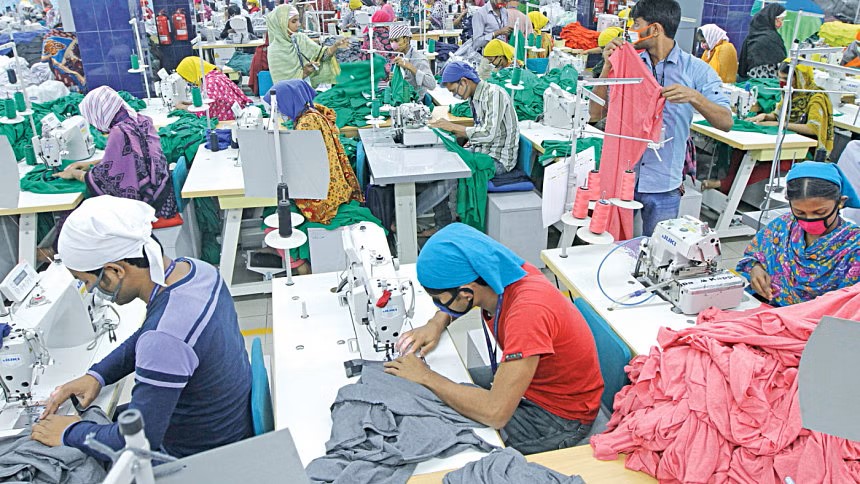The robust growth in garment export has not been reflected in employment creation in the sector, according to an expert.
Between 2008 and 2022, Bangladesh’s garment exports grew from $10 billion to $42 billion. However, employment in the sector is almost stagnant around 3.5 million to 4 million.
“Automation and infusion of labour-saving technology is the reason for the stagnant employment in the sector,” said Mohammad Abdur Razzaque, chairman of the Research and Policy Integration for Development (RAPID).
He was presenting a keynote at a technical dialogue on “National Employment Policy and Labour Market Employment Challenges in Bangladesh” jointly organised by the labour and employment ministry and International Labour Organization (ILO) at InterContinental Dhaka yesterday.
“One of the principal reasons for weak employment generation in the manufacturing sector is being increasingly attributed to the use of more capital-intensive technologies and automation,” said Razzaque.
This is coming about as the services and industry sectors’ employment shares are not expanding proportionately with the GDP, he said.

Though Bangladesh’s garment exports grew from $10 billion to $42 billion between 2008 and 2022, employment in the sector is almost stagnant at around 3.5 million to 4 million. Photo: Star/file
Since 2010, the share of the industrial sector in the GDP increased by more than 10 percentage points to 36.9 per cent, but the share of employment fell by 1 percentage points to 17 per cent, her said in a presentation.
According to Labour Force Survey (LFS) 2017, workers employed in the industrial sector have fallen by 3.5 lakh (0.35 million) from 12.4 million to 12.05 million in 2022, read the presentation.
Meanwhile, the average real GDP output of the industrial sector grew by more than 9 per cent per annum. On an average, 65 per cent of industrial GDP output comes from manufacturing, it added.
Between LFS 2013 and 2017, manufacturing employment declined by 0.7 million. But the manufacturing GDP grew by Tk 648 billion (average growth of 9 per cent) during the same time, it read.
Provisional report of LFS 2022 did not report the share of employment of manufacturing sectors, it said.
His presentation was on “Labour Market Dynamics in Bangladesh and the National Employment Policy (NEP) 2022”.
The NEP includes provisions for skills development of both domestic and migrant workers, establishment of labour market information system (LMIS), creation of national employment database, etc.
The policy identified 11 challenges to creating skilled manpower in Bangladesh, including inadequate sector-based training centres with modern technology, lack of education and language proficiency of workers, shortage of modern benefits, instruments and skilled trainers and weakness in operating and monitoring training institutes.
A lack of government and private initiatives to create a productive labour force and lack of sector-based modern training manuals and trainers are also key challenges.
Razzaque said the NEP 2022 was a welcome initiative as its objectives and “issues for consideration” were well-specified.
“However, its effective implementation will be most important,” he said.
“It requires a concrete time-bound national action plan with clear and pragmatic goals. The NEP should be subject to regular periodical review/monitoring and evaluation mechanisms to assess progress and undertake any corrective measures,” he added.
Begum Monnujan Sufian, state minister of labour and employment, said the Ministry of Labour and Employment, together with other ministries and stakeholders, would pursue evidence-based policy development and targeted interventions to create an enabling environment for decent employment opportunities.
“This initiative will be aligned with the employment policy developed last year. As part of its implementation, the Ministry of Labour and Employment is also exploring the establishment of an employment directorate to coordinate the employment agenda,” she said.
Tuomo Poutiainen, country director for ILO Bangladesh, ensured ILO’s support for the Bangladesh government to achieve the United Nations country status graduation and Vision 2041 by implementing a 4th decent work country programme.
“It is evident that jobs creation, social security, quality of employment and international trade are crucial to achieve the goals, but the national employment policy could be the pivotal tool to pushing employment agenda further in connection to achieve the country’s vision,” he said.
“Promoting the creation of full and productive employment has been an integral part of ILO’s work in Bangladesh,” he said.
“This is because decent jobs are not just any jobs but the basis for peace, social justice, social inclusion, economic development, and personal fulfilment,” he added.
Md Kawser Ahmed, member (secretary) of General Economics Division (GED), Sharifa Khan, secretary to Economic Relations Division, Shahnaz Arefin, secretary to Statistics and Informatics Division, and Sher Singh Verick, acting chief for employment, labour market and youth branch of ILO, were present.
















